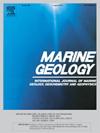Impact of Paleocene–Eocene tectonic and climatic forcing on Arctic sediment transfer variability: SW Barents Sea, Norway
IF 2.6
3区 地球科学
Q2 GEOSCIENCES, MULTIDISCIPLINARY
引用次数: 0
Abstract
During the Paleocene and Eocene, many Arctic basins experienced multiple, yet synchronous periods of increased sedimentation rates. Several causal factors have been suggested including major volcanic events, tectonic plate reorganization and plate break-up, as well as widespread uplift along with contemporaneous and short-lived hyperthermal events. However, the significance of and relation between tectonic and climatic forcing on Arctic sediment transfer during the early Paleogene are poorly understood. In this case study from the Barents Shelf margin in the Norwegian Arctic, we present previously unpublished cores combined with exploration wells, and new high-resolution 3D seismic data to investigate sedimentary stacking patterns and geomorphological features in the Sørvestsnaget Basin. Our integrated investigations reveal the development of climate-controlled and tectonically-driven submarine fans. The PETM fans display an individual fan as a result of single depositional event compared to the middle Eocene fans that show stacked submarine fans probably deposited during multi-phase events. Our stratigraphic forward modelling analysis indicates that regional-scale tectonically induced uplift significantly increased the amount of sand delivered to the basin as documented by a thickening of the basin fill succession. The climatic component contributes to sand transport variability to the basin, and thus the temporal evolution pattern of sand is much varied. Finally, we discuss our findings with the tectonic and climatic forcing factors in a circum-Arctic perspective.
古新世-始新世构造和气候强迫对北极沉积物转移变率的影响:挪威西南巴伦支海
在古新世和始新世期间,许多北极盆地经历了多个同步的沉积速率增加时期。主要的火山活动、构造板块重组和板块破碎、广泛的隆升以及同时期和短暂的高温活动是其形成的原因。然而,早古近纪构造强迫和气候强迫对北极沉积物转移的意义及其相互关系尚不清楚。在挪威北极地区巴伦支陆架边缘的案例研究中,我们使用了以前未发表的岩心,结合探井,以及新的高分辨率3D地震数据来研究Sørvestsnaget盆地的沉积叠加模式和地貌特征。我们的综合调查揭示了气候控制和构造驱动的海底扇的发展。始新世中期扇显示出可能是多期沉积,而始新世中期扇显示出可能是多期沉积。我们的地层正演模拟分析表明,区域尺度构造引起的隆升显著增加了向盆地输送的砂量,这一点可以通过盆地充填序列的增厚来证明。气候因素对沙尘向盆地输运的变异性起着重要的作用,因此沙尘的时间演化模式具有很大的差异性。最后,我们从环北极的角度讨论了构造和气候强迫因子的发现。
本文章由计算机程序翻译,如有差异,请以英文原文为准。
求助全文
约1分钟内获得全文
求助全文
来源期刊

Marine Geology
地学-地球科学综合
CiteScore
6.10
自引率
6.90%
发文量
175
审稿时长
21.9 weeks
期刊介绍:
Marine Geology is the premier international journal on marine geological processes in the broadest sense. We seek papers that are comprehensive, interdisciplinary and synthetic that will be lasting contributions to the field. Although most papers are based on regional studies, they must demonstrate new findings of international significance. We accept papers on subjects as diverse as seafloor hydrothermal systems, beach dynamics, early diagenesis, microbiological studies in sediments, palaeoclimate studies and geophysical studies of the seabed. We encourage papers that address emerging new fields, for example the influence of anthropogenic processes on coastal/marine geology and coastal/marine geoarchaeology. We insist that the papers are concerned with the marine realm and that they deal with geology: with rocks, sediments, and physical and chemical processes affecting them. Papers should address scientific hypotheses: highly descriptive data compilations or papers that deal only with marine management and risk assessment should be submitted to other journals. Papers on laboratory or modelling studies must demonstrate direct relevance to marine processes or deposits. The primary criteria for acceptance of papers is that the science is of high quality, novel, significant, and of broad international interest.
 求助内容:
求助内容: 应助结果提醒方式:
应助结果提醒方式:


